Juniper jn0-648 practice test
Enterprise Routing and Switching, Professional Exam
Question 1
Refer to Exhibit: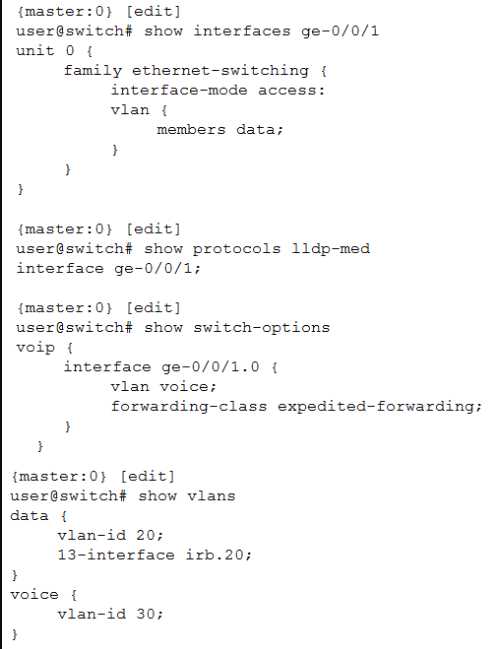
You have a workstation and a VoIP phone connected to port ge-0/0/1 on an access switch.
Referring to the exhibit, which two statements are true? (Choose two.)
- A. Frames that exit interface ge-0/0/1 on the data VLAN will be tagged.
- B. The phone will automatically be assigned a VLAN ID.
- C. Voice frames that enter interface ge-0/0/1 will be forwarded as expedited forwarding traffic.
- D. All frames that exit interface ge-0/0/1 will belong to the data VLAN.
Answer:
BC
Explanation:
https://www.juniper.net/documentation//en_US/junos/topics/topic-map/802-1x-and-voip-on-switches.html#id-example-setting-up-voip-with-8021x-and-lldp-med-on-an-ex-series-switch
https://www.juniper.net/documentation/en_US/junos/topics/topic-map/device-discovery-using-lldp-lldp-med.html
Question 2
You are asked to deploy 802.1X on your EX Series switches. You need to ensure authenticated devices
continue to have access to the network even if the authentication server fails.
Which action meets this configuration objective?
- A. Configure the server fail fallback with a value of sustain.
- B. Set the reauthentication interval to a value of 0.
- C. Configure the static MAC bypass for the authentication server.
- D. Set the reauthentication interval to a value of disable.
Answer:
A
Explanation:
https://www.juniper.net/documentation/us/en/software/junos/user-access/topics/concept/802-1x-pnac-divert-authentication-understanding-mx-series.html
Question 3
In a Layer 2 environment where 802.1X is deployed, which two statements are correct? (Choose
two.)
- A. RADIUS messages are exchanged between the supplicant and the authenticator.
- B. RADIUS messages are exchanged between the authenticator and the authentication server.
- C. Extensible Authentication Protocol messages are exchanged between the authenticator and the authentication server.
- D. Extensible Authentication Protocol messages are exchanged between the supplicant and the authenticator.
Answer:
BD
Explanation:
https://en.wikipedia.org/wiki/IEEE_802.1X
Question 4
Which two statements about OSPF routing policies are correct? (Choose two.)
- A. By default, OSPF export policies reject network-summary LSAs.
- B. By default, OSPF export policies accept network-summary LSAs.
- C. By default, OSPF import policies accept network-summary LSAs.
- D. By default, OSPF import policies reject network-summary LSAs.
Answer:
AC
Question 5
Click the Exhibit button.
You receive the same 75.100.0.0/16 route from all four ISPs to which you are connected.
Referring to the exhibit, which ISPs route will be selected as active?
- A. ISP-D
- B. ISP-C
- C. ISP-B
- D. ISP-A
Answer:
A
Explanation:
https://www.juniper.net/documentation/en_US/junos/topics/reference/general/routing-protocols-address-representation.html
Question 6
Click the Exhibit button.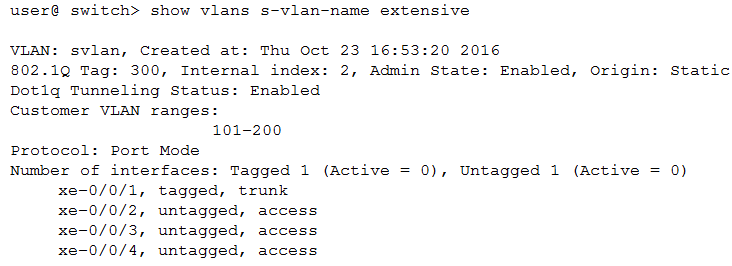
During an outage, you review the status of the Q-in-Q implementation on VLAN 300.
Referring to the exhibit, what would be the cause of the outage?
- A. The S-VLAN is disabled.
- B. The VLAN range overlaps.
- C. The C-VLANs are disabled.
- D. There are no active ports.
Answer:
D
Question 7
Your IPv4 multicast network uses different MX Series routers for the source DR and the PIM sparse-
mode RP.
What is required before PIM register messages are exchanged between the DR and RP routers?
- A. Add a tunnel services PIC to the RP router.
- B. Add an adaptive services PIC to the DR router.
- C. Enable tunnel services on the DR and RP routers.
- D. Configure PIM encapsulation on the DR and RP routers.
Answer:
C
Question 8
Click the Exhibit button.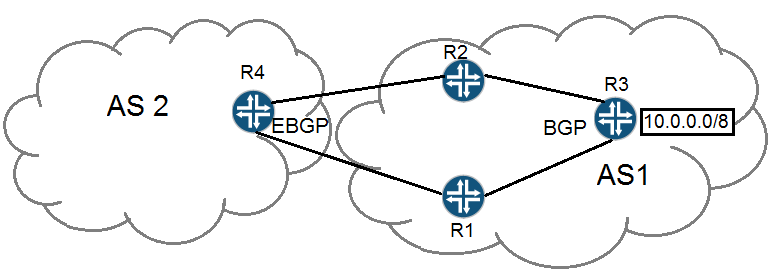
Which well-known community needs to be used to restrict 10.0.0.0/8 from being advertised to AS 2?
- A. no-publish
- B. no-advertise
- C. no-export-subconfed
- D. no-export
Answer:
D
Explanation:
https://routersysco.wordpress.com/2011/12/21/bgp-community-attribute-no-advertise-no-
export/#:~:text=%2Dno%2Dadvertise%20means%E2%80%94Do,this%20route%20within%20an%20A
S
.
no-advertiseRoutes in this community name must not be advertised to other BGP peers.
no-exportRoutes in this community must not be advertised outside a BGP confederation boundary.
A stand alone autonomous system that is not part of a confederation should be considered a
confederation itself.
no-export-subconfedRoutes in this community must not be advertised to external BGP peers,
including peers in other members ASs inside a BGP confederation.
Question 9
When configuring 802.1X authentication, what are three server fail fallback settings? (Choose three.)
- A. log
- B. sustain
- C. permit
- D. count
- E. move
Answer:
BCE
Explanation:
https://www.juniper.net/documentation/en_US/junos/topics/topic-map/radius-server-configuration-ex-series-cli.html#id-configuring-radius-server-fail-fallback-cli-procedure
https://www.juniper.net/documentation/en_US/junos/topics/topic-map/radius-server-configuration-ex-series-cli.html
Permit authentication, allowing traffic to flow from the end device through the interface as if the end
device were successfully authenticated by the RADIUS server.
Deny authentication, preventing traffic from flowing from the end device through the interface. This
is the default.
Move the end device to a specified VLAN if the switch receives a RADIUS access-reject message. The
configured VLAN name overrides any attributes sent by the server. (The VLAN must already exist on
the switch.)
Sustain authenticated end devices that already have LAN access and deny unauthenticated end
devices. If the RADIUS servers time out during reauthentication, previously authenticated end
devices are reauthenticated and new users are denied LAN access.
Question 10
Click the Exhibit button.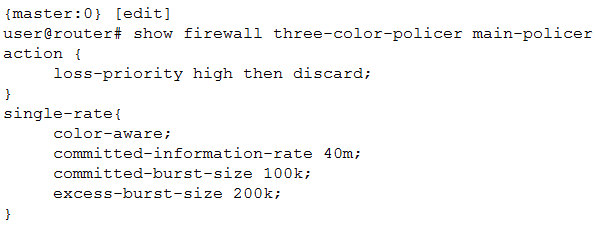
You have configured and applied the policer shown in the exhibit to your Junos device.
Which statement is true in this scenario?
- A. Traffic exceeding the committed-burst size will be marked with a loss priority of high.
- B. Traffic exceeding the excess-burst size will be discarded.
- C. Traffic exceeding the committed-information-rate will be rate limited.
- D. Traffic exceeding the committed-burst size will be discarded.
Answer:
B
Explanation:
RedTraffic that exceeds the burst size for peak traffic (EBS), single-rate marks packets with an
implicit loss priority of high and, optionally, discards the packets.
https://www.juniper.net/documentation/en_US/junos/topics/topic-map/policer-single-rate-three-color.html
https://www.juniper.net/documentation/us/en/software/junos/routing-policy/topics/topic-map/policer-single-rate-three-color.html
Question 11
Your company has expanded into office space across the street. The new office space has a single
Ethernet
connection connected to an unmanaged switch. You must sort traffic based on the IP address into
different
VLANs once the traffic arrives on your EX Series switches.
D18912E1457D5D1DDCBD40AB3BF70D5D
Which mechanism would you use to accomplish this task?
- A. MVRP
- B. filter-based VLANs
- C. Q-in-Q tunneling
- D. dynamic VLANs
Answer:
B
Explanation:
https://next-hop-self.com/juniper-filter-based-vlan-assignment.html
https://www.juniper.net/documentation/us/en/software/junos/routing-policy/topics/example/firewall-filter-ex-series-configuring.html
Question 12
Click the Exhibit button.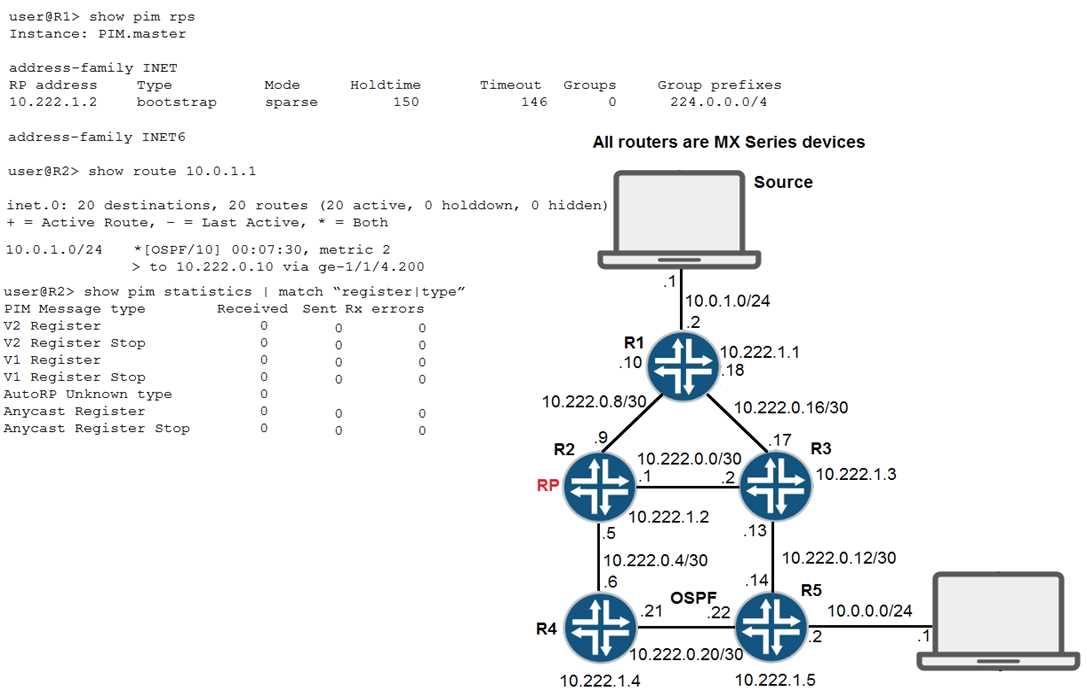
Referring to the exhibit, the source is currently sending multicast traffic using group 224.1.1.1, which
is being received by R1. R2 is not receiving PIM register messages.
What would be the cause of this problem?
- A. Tunnel services have not been enabled on R1.
- B. All routers have not been configured with the same Auto-RP discovery group.
- C. R5 has not received an IGMP report of 224.1.1.1.
- D. A(*,G) tree has not been built yet.
Answer:
A
Explanation:
The multicast traffic being sent by the source must be encapsulated into a PIM register packet. If the
tunneling services under the chassis stanza is not configured, a PE (PIM Encapsulation interface) will
not be present in the multicast first hop router. Anyway long story short, tunneling services must be
turned on or else you will not get PIM register messages sent to the RP.
https://kb.juniper.net/InfoCenter/index?page=content&id=KB13329
Question 13
Click the Exhibit button.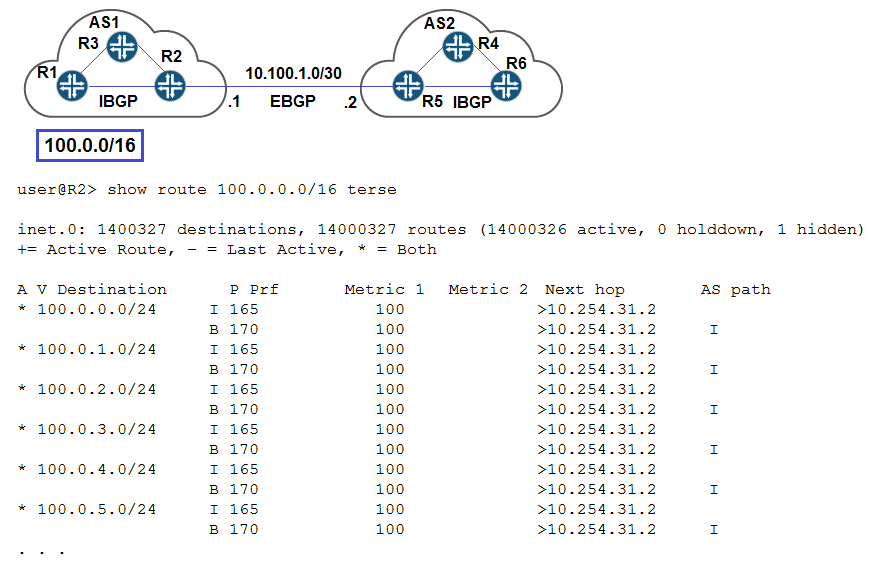
Referring to the exhibit, you must advertise the 100.0.0.0/16 routes from AS1 to AS2, but R2 is not
advertising any BGP routes to R5.
Why is this happening in this scenario?
- A. The IBGP routes will not be advertised because you must use a policy to advertise IBGP routes.
- B. The IBGP routes are not active and EBGP will advertise only active routes.
- C. The IBGP routes will not be advertised because the AS path shows as incomplete.
- D. The IBGP routes are not active because the next hop is not reachable.
Answer:
B
Explanation:
https://www.juniper.net/documentation/en_US/junos/topics/concept/policy-routing-policies-actions-defaults.html
Default BGP Export Policy:
Readvertise all active BGP routes to all BGP speakers, while following protocol-specific rules that
prohibit one IBGP speaker from readvertising routes learned from another IBGP speaker, unless it is
functioning as a route reflector.
ed@vMX-PE1# show protocols bgp group eBGP | display set
set protocols bgp group eBGP type external
set protocols bgp group eBGP family inet unicast rib-group inet0-to-test
set protocols bgp group eBGP peer-as 3
set protocols bgp group eBGP neighbor 10.0.13.3
[edit]
ed@vMX-PE1#
Question 14
You have an IPv4 multicast network configured as PIM-SM.
What must be done before replacing your static RP with auto-RP?
- A. Enable sparse-dense mode on each of the routers in the network.
- B. Configure auto-RP domains on each router in the network.
- C. Configure each router in the network as a candidate BSR.
- D. Enable each router in the network to forward multicast packets.
Answer:
A
Explanation:
https://www.juniper.net/documentation/en_US/junos/topics/task/configuration/mcast-pim-auto-rp.html
"Because PIM dense mode is necessary to enable auto-RP to work, which in turns enables PIM
sparse mode to work, you must configure PIM sparse-dense mode in the PIM domains that use auto-
RP."
Question 15
You have multiple BGP routes to the same prefix with equal local-preference values and AS-path
lengths.
In this scenario, which route will be preferred in the route selection process?
- A. The route with the least preferred origin value.
- B. The route with the lowest MED value.
- C. The route with the most preferred origin value.
- D. The route with the highest MED value.
Answer:
C
Explanation:
https://www.juniper.net/documentation/en_US/junos/topics/reference/general/routing-protocols-address-representation.html